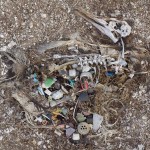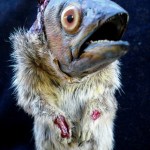Science
Heartbreaking photos of albatross chicks, by photographer Chris Jordan:
These photographs of albatross chicks were made just a few weeks ago on Midway Atoll, a tiny stretch of sand and coral near the middle of the North Pacific. The nesting babies are fed bellies-full of plastic by their parents, who soar out over the vast polluted ocean collecting what looks to them like food to bring back to their young. On this diet of human trash, every year tens of thousands of albatross chicks die on Midway from starvation, toxicity, and choking.To document this phenomenon as faithfully as possible,…
I was going to join PZ Myers, ERV, and Pamela Ronald in helping out an old blogging friend and former host of the Skeptics' Circle, Karl Mogel of The Inoculated Mind by pimping his other science-based blog Biofortified, which seeks to provide a science- and evidence-based discussion of plant genetics and genetic engineering. Unfortunately, as seems to be the case lately, other things have distracted me, and I'm late to the party. Better late than never, though.
Basically, Biofortified is in the Ashoka Changemakers contest, GMO Risk or Rescue. First prize is a $1500 grant and a conversation…
Oh, look. A homeopath explains physics to us all.
I'm sorry. Did I break your brain?
Here's a non-homeopathic cure. It takes an hour of Lawrence Krauss to counter 8 minutes of that kind of lunacy, I'm afraid.
Image: wemidji (Jacques Marcoux).
Nam et ipsa scientia potestas est (And thus knowledge itself is power)
-- Sir Francis Bacon.
Would you like to share your excellent writing about science, nature or medicine with the world? Now you can! There is a blog carnival that celebrates the best writing in the blogosphere about these topics and we are seeking submissions from you, the reading and writing public that you think are suitable for this blog carnival.
Scientia Pro Publica (Science for the People) was just published recently. This edition is entitled Scientia Pro Publica -- 14th edition…
Here's a good science blog you can help: Biofortified, a group blog on plant genetics and genetic engineering (and, by the way, Sb's recent addition, Pamela Ronald, is part of the team). They are in a contest to win a small cash grant and an interview with Michael Pollan, and this group is thoroughly deserving — Biofortified is kind of the Panda's Thumb of plant genetic engineering.
Unfortunately, they're in second place right now, trailing an anti-genetic engineering, industry sponsored site, and they need more votes to win. You can help out!
To do so, though, is a little more cumbersome…
Image: wemidji (Jacques Marcoux).
Nam et ipsa scientia potestas est (And thus knowledge itself is power)
-- Sir Francis Bacon.
When you go hiking or sailing or stargazing, why not consider writing about your experience of nature and sharing it with the world? Or maybe you are watching an ant's nest in the crack of a sidewalk, walking down the beach, flipping rocks to see what's underneath, or sitting in your kitchen, watching birds eating seeds at your birdfeeders? Your experiences could be interesting to others if these activities provide you with questions that you decide to investigate…
tags: Birdbooker Report, bird books, animal books, natural history books, ecology books
"How does one distinguish a truly civilized nation from an aggregation of
barbarians? That is easy. A civilized country produces much good bird
literature."
--Edgar Kincaid
The Birdbooker Report is a special weekly report of a wide variety of science, nature and behavior books that currently are, or soon will be available for purchase. This report is written by one of my Seattle birding pals and book collector, Ian "Birdbooker" Paulsen, and is edited by me and published here for your information and…
"Mechanical heart"
Bill McConkey
Collage of a digitally enhanced pencil drawing of the human heart and photographs of different brass instruments. Digital artwork. From the Wellcome Image Awards 2009 - see the other winners here.
Last week was Open Access Week, which meant I got to hear a great talk from John Wilbanks of the Science Commons (you should subscribe to their blog!) I've been thinking a lot this week about the legal challenges of data sharing, which is giving me a headache. But there's an easier way to celebrate Open Access Week: by visiting the Guardian's a multimedia show about…
My panel on "Communicating Science in the 21st Century" was last night at the Quantum to Cosmos Festival at the Perimeter Institute. I haven't watched the video yet-- Canadian telecommunications technology hates me, and I'm lucky to get a wireless connection to stay up for more than ten minutes-- but if the video feeds I've seen from other talks are an indication, it should be really good.
The panel wound up being primarily about journalism, which is understable given that the other four participants are all very distinguished journalists. I did my best to uphold the honor of the New Media…
Last week was Open Access Week. At the risk of sounding like a stick-in-the-mud, let me play devil's advocate to the blogosphere's near-universal celebration of Open Access (abbreviated, OA). Thus: I don't think most OA advocates have thought deeply enough about long-term implications.
First, though, what is Open Access?Â
OA is a publication model where scholars (or their subsidizers) foot the bill and readers enjoy studies free of charge. Anyone can log on and read an OA article with nary a registration or fee. OA marks a radical change from the traditional model, where most…
Image: wemidji (Jacques Marcoux).
Nam et ipsa scientia potestas est (And thus knowledge itself is power)
-- Sir Francis Bacon.
Scientia Pro Publica (Science for the People) was just published recently. This edition is entitled Scientia Pro Publica -- 14th edition. The author of Genetic Interference is speaking (right now!) at the American Society of Human Genetics Annual Meeting and is planning to "live blog" that conference as well, despite the fact it's in Hawai'i, so be sure to poke around on his blog to find those essays.
Scientia Pro Publica (Science for the People) is a…
Has your week been like this, too? I'm just checking. . .
"Fish in a squirrel suit" by Slightly Curious.
Via Regretsy.
I'm heading to the airport right after my second class today (I'm doing two weeks of our first-year seminar class), to appear at the Quantum to Cosmos Festival at the Perimeter Institute in Waterloo. This promises to be a good event-- I had a great time at the Science in the 21st Century workshop last fall, and they've got a great program lined up for the festival.
I'm most likely going to attend tonight's tv broadcast, and tomorrow's "Quantum Physics in 60 Minutes" lecture (I have a professional interest in seeing how the competition does things), but I'm making the trip in order to appear…
David Sloan Wilson certainly got a warm and appropriate welcome here. His first post was titled Science as a Religion that Worships Truth as its God, a phrase that purées together both "religion" and "science" with "truth" as a wickedly wielded whisk, and immediately set a number of people on edge. Eric Michael Johnson jumped on it, as did Henry Gee (I know he irritated many of the regulars here last time he dropped by, but trust me, sometimes he does say smart things). Gee, in particular, succinctly corrected the title to be "Science as a Religion that Worships Doubt as its God", which is…
Image: wemidji (Jacques Marcoux).
Nam et ipsa scientia potestas est (And thus knowledge itself is power)
-- Sir Francis Bacon.
Scientia Pro Publica (Science for the People) was just published recently. This edition is entitled Scientia Pro Publica -- 14th edition. The author of Genetic Interference is speaking (right now!) at the American Society of Human Genetics Annual Meeting and is planning to "live blog" that conference as well, despite the fact it's in Hawai'i, so be sure to poke around on his blog to find those essays.
Scientia Pro Publica (Science for the People) is a…
You sometimes hear people say that it's good to make a splash when embarking on a new media project. David Sloan Wilson has apparently taken this to heart, and tucks himself into a tight ball as he leaps off the high board into the ScienceBlogs pool:
Thinking of science as a religion that worships truth as it god enables me to praise its virtues and criticize its shortcomings at the same time. In my previous blogs, I have played the role of scientific reformer for two major issues. The first is the "new atheism" movement spearheaded by the so-called four horsemen: Richard Dawkins, Daniel…
A sampling of face patterns in Polistes fuscatus paper wasps
Polistes fuscatus paper wasps sport a bewildering array of facial markings. Why is this?
A new paper by Michael Sheehan and Elizabeth Tibbetts in the journal Evolution suggests natural selection may favor rare patterns, leading to a proliferation of diversity. Sheehan & Tibbetts performed an elegant experiment on 18 groups of 4 foundress queens, painting three wasps with one pattern and the remaining one with a different pattern. Regardless of the details of the actual face markings, the rare pattern…
I've been buried in lab grading for a lot of this week, but I'm finally down to the last few stragglers. The experience has me thinking a bit about what we're doing here, and talking to people in other departments, and it seems like a good question for my wise and worldly readers.
At the moment, we run on 10-week terms, and in a ten-week term, we typically do seven labs (the other three are canceled to make time for exams, or to avoid doing labs in the first or last week of the term. Some fraction of those seven labs are full formal reports, with an abstract, introduction, procedure, results…
My friend Konrad showed me this awesome toy he made.
I know it doesn't make sense yet, so let me explain. Basically, you take this marble and roll it down the tray through the pegs. The pegs sort of randomize where the marble rolls through the hidden section. Inside the hidden section, it looks like this:
The object of this toy is to find the cross-sectional area of the rings. Konrad said he built this based off of a toy he was given in middle school. He wasn't told how to do it, just to do it. Maybe I shouldn't say anymore about that toy except that it is awesome. No instructions,…
Click to Gigapan this Linepithema ant head
Gigapan is a technology that stitches together hundreds of individual images to form a massive single image. It's hard to appreciate its power from just the small SEM image shown above, but if you click on the photo you'll be able to zoom to a marvelous level of detail.
More clickable gigapan ants below the fold.


